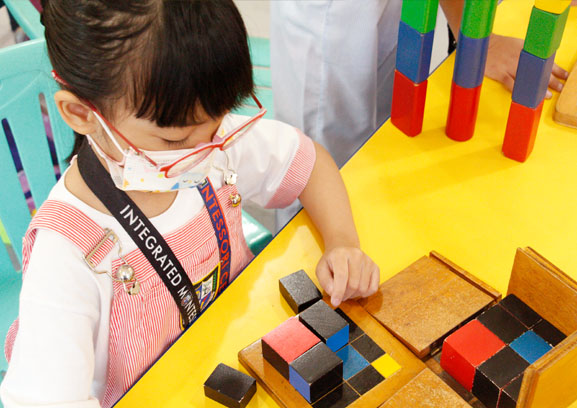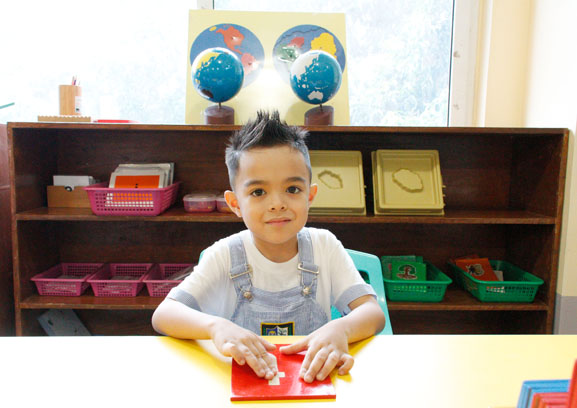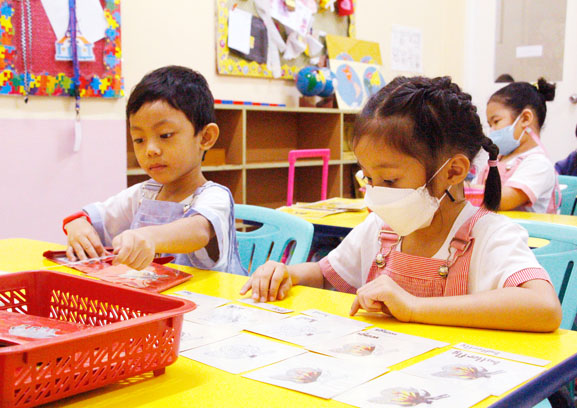THE MONTESSORI METHOD OF EDUCATION
The Montessori system is a learning approach directed by an ardent goal, which is to aid the child’s development into a complete adult human being, comfortable with himself, with his society and with humanity as a whole.
The Montessori Method of education, developed by Dr. Maria Montessori, is a child-centered teaching approach established on a scientific observation of children from birth to adulthood. It is a viewpoint of a child as one who is instinctively eager for knowledge and capable of initiating learning in a supportive, deliberately prepared learning environment. It is an approach that gives importance to the human spirit and to the physical, social, emotional and cognitive development of the whole child.
The TRAINED TEACHER, CHILD, and PREPARED ENVIRONMENT create a learning triangle. The classroom is readied by the directress or trained teacher to encourage independence, freedom within limits and a sense of order. The child, through individual choice utilizes what the environment offers to establish and develop him. He interacts with the trained teacher only when support and/or guidance are needed.
The Montessori prepared environment is classified into 5 learning areas namely:
1. PRACTICAL LIFE EXERCISES
Practical Life Exercises are the foundation of the Montessori environment. They provide a beneficial range of activities which allow the children to develop control and coordination of movement, awareness of their environment, orderly thought patterns, independent work habits, responsibility, and many other characteristics which can only be attained through spontaneous, purposeful work.

2. SENSORIAL MATERIALS
Montessori sensorial materials are materials used in the Montessori classroom to help a child develop and refine his or her five senses. Use of these materials creates the next level of difficulty after those of practical life.
Like many other materials in the Montessori classroom, sensorial materials have what is called "control of error", meaning that the child not only works with the material, but also has a way to check the work rather than seeking out the trained teacher. This is done to help promote independence on the part of the child.

3. MATH MATERIALS
Montessori believed that a child's mind is mathematical and based on the order of perceptual awareness found in the development of the senses. The acquisition of mathematical principles is seen as developing logically from concrete to abstract, and from simple to complex. The Montessori Math includes the development of concepts such as numeration, place value, fractions, and the basic operations of addition, subtraction, multiplication, and division using numbers up to 9999.
.jpg)
4. LANGUAGE
With the Montessori Language materials, the child teaches himself how to write and read. The child uses sandpaper letters, metal insets, and movable alphabets. The child progresses from learning the phonetic sounds of the alphabet, blending and reading simple three letter phonetic words and gradually progresses to longer phonetic words, non-phonetic sounds, phrases, sentences, paragraphs and to books. The child learns how to write and read in print and in cursive and learns the function of words through the Montessori grammar materials.

5. CULTURAL ARTS
Every child has an innate curiosity about the world and his surroundings. To address this eagerness, the trained Montessori teacher introduces the children to the composition of earth, land, water and air. She then leads them to understanding the concept of globe, land and water forms and the different continents that make up the world.

